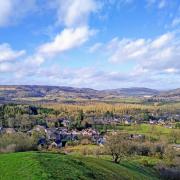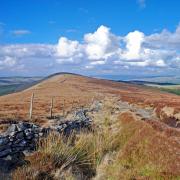Detailing the fate of US Air Force Boeing RB-29A Superfortress, which came down in the Peak District in adverse weather conditions in 1948.
Bleaklow is a place of remote beauty. Yet on its moors lie evidence of a tragedy which occurred over 70 years ago
The Peak District’s Dark Peak is a place of natural wonder.
For centuries, people have navigated its beautiful yet desolate landscapes.
There is something captivating and exhilarating about traversing its moorlands, plateaus and steep-sided cloughs that have existed here for centuries. The benefits are numerous, but this is an area that demands respect.
Bleaklow is one such area. Located north of Kinder Scout – Derbyshire’s highest point – this largely peat-covered moorland rises almost 2,000 feet above sea level.
For all its appeal – and the area is enjoyed safely by thousands each year – parts of Bleaklow’s landscape betrays times of jeopardy and, ultimately, human tragedy.
Nothing quite optimises the often-harsh nature of this landscape than the fate of US Air Force Boeing RB-29A Superfortress, which came down here in adverse weather conditions in 1948, claiming the lives of all those aboard – including eleven crew and two military passengers.
Prior to its crash on Bleaklow, the aircraft’s time in service had been a varied and interesting one. Modified for photographic assignments, the bomber bore the striking name Over Exposed having been flown in July 1946 to take images of American nuclear testing at Bikini Atoll.
Bikini Atoll, meaning ‘coconut place’ is one of 23 small islands which make up the remote Marshall Islands in the Pacific Ocean, equidistant between the United States and Australia.
The same aircraft had also been involved in the Berlin airlift in the same year, which had come about as a result of a Soviet blockade of land routes into West Berlin following the conclusion of the Second World War.

However, despite its numerous assignments to locations across Europe and the globe, Bleaklow, high up in the Peak District, would be its final location – it remains there to this day.
On November 3 1948, the Superfortress had been conducting a routine flight, having departed RAF Scrampton, near Lincoln, at 10:15am en-route to the US Air Force base at Burtonwood, 125 miles away.
Relying on instruments far more rudimentary than those found in modern aircraft and hampered by low cloud, the plane made the fatal miscalculation - based on flight time - that they were past the hills of Bleaklow and began to descend.
Around forty-five minutes after take-off, the aircraft hit Higher Shelf Stones where it burst into flames and crashed, costing the lives of all those on board. The remains of the plane were located at around 4.30pm the same day as the light began to fade. Only the tail section remained intact.
Over seventy-five years since the tragic event on Bleaklow, debris still lies abandoned, with significant amount of the wreckage remaining visible, including wing and fuselage sections, the undercarriage and gun turrets as well as the Duplex-Cyclone engines, which sit dramatically where they fell.
Despite the destruction, the payroll which had travelled with the aircraft, totalling around £7,000, survived, found untouched in a sack.
The crash scene was still giving up secrets as late as the 1970s, when a local man found a ring at the site. It was later identified as the wedding ring of Captain Tanner, one of the eleven to be lost, and subsequently returned to his daughter.
The wreckage has never been moved or cleared since Over Exposed came down on that fateful day, although not every element of the crash site has survived.
After the investigation team had finished their duties, the aircraft’s tail fin, which had remained up-right on impact, was destroyed due to it attracting too many sightseers, a result of it being visible for miles around.
A gun turret, meanwhile, was removed with permission granted by the Ministry of Defence. It can now be found in the air museum at Newark.

These days, an American flag flies as a tribute to those who perished, alongside a memorial, erected in 1988, to honour the crew’s memory. It reads:
‘Here lies the wreckage of B-29 Superfortress ‘Over Exposed’ of the 16th. Photographic reconnaissance squadron USAF. Which tragically crashed whilst descending through cloud on 3rd November 1948 killing all 13 crewmembers. The aircraft was on a routine flight from RAF Scampton to American AFB Burtonwood. It is doubtful the crew ever saw the ground. Memorial laid by 367 Air Navigation Course of RAF Finningley on November 12th 1988.’
Over Exposed – sometimes referred to as the ‘Bleaklow Bomber’ - was not the first or last aircraft to succumb to harsh and difficult conditions over Bleaklow in the dangerous days before modern navigation technology.
There are at least a further seven recorded crashes which occurred in the area that cost the lives of those on board, many of which occurred in the 1940s.
It was, however, the fate of Over Exposed which has left the most enduring and visible mark on the landscape, an area that appears frozen in time since the day of the incident.
Today, the site remains popular with walkers and Derbyshire Life’s popular Derbyshire and Peak District Walks Facebook group receives dozens of photos and comments on almost weekly basis from hikers who have made the journey there, not out of morbid curiosity but to take in this moving and poignant site and to pay their respects.
For anyone wishing to visit the site, it’s worth noting that the area in which the remains of Over Exposed can be found can be extremely challenging to get to in adverse weather and that conditions here are notorious for changing very quickly.
This article includes extracts from Abandoned Derbyshire, written by Nathan Fearn, due for release in 2023.




























